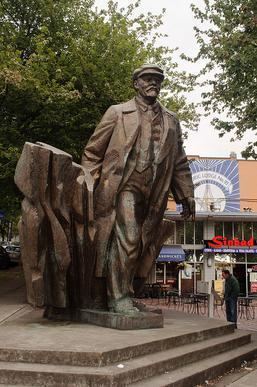Year 1988 (1988) Medium Bronze Dimensions 5 m (16 ft) Artist Emil Venkov Created 1988 | Type Sculpture Subject Vladimir Lenin Location Seattle, Washington Phone +1 206-632-1500 | |
 | ||
Address Fremont Place North & N 36th St, Seattle, WA 98103, USA Hours Open today · Open 24 hoursSundayOpen 24 hoursMondayOpen 24 hoursTuesdayOpen 24 hoursWednesdayOpen 24 hoursThursdayOpen 24 hoursFridayOpen 24 hoursSaturdayOpen 24 hoursSuggest an edit Similar Fremont Troll, Vladimir Lenin monume, Aurora Bridge, Fremont Bridge, Grūtas Park | ||
The statue of lenin in the fremont district of seattle
The Statue of Lenin is a 16-foot (4.9 m) bronze sculpture of Communist revolutionary Vladimir Lenin located in the Fremont neighborhood of Seattle, Washington. Initially installed in Czechoslovakia in 1988, the sculpture was removed after the Velvet Revolution and later purchased and brought to the United States by an American English teacher in the 1990s.
Contents
- The statue of lenin in the fremont district of seattle
- Background
- Acquisition and move to Seattle
- Fame
- References
Background
The statue was constructed by a Bulgarian sculptor Emil Venkov, under a 1981 commission from the Communist Party of Czechoslovakia. While following the bounds of his commission, Venkov intended to portray Lenin as a bringer of revolution, in contrast to the traditional portrayals of Lenin as a philosopher and educator.
Venkov's work was completed and installed in Poprad, Czechoslovakia (now Slovakia), in 1988 at a cost of 3,340,000 Czechoslovak koruna ($111,333 in 1993 United States dollars), shortly before the fall of Czechoslovak communism during the 1989 Velvet Revolution. Despite popular belief, the Poprad Lenin was not toppled in the demonstrations during the fall of communism. Instead, it was quietly removed from Lenin's Square, in front of Poprad's main hospital, several months after the Velvet Revolution.
Acquisition and move to Seattle
Lewis E. Carpenter, an English teacher in Poprad originally from Issaquah, Washington, found the monumental statue lying in a scrapyard ready to be sold for the price of the bronze; Carpenter had met and befriended Venkov while in Czechoslovakia. In close collaboration with a local journalist and good friend, Tomáš Fülöpp, Carpenter approached the city officials with a claim that despite its current unpopularity, the sculpture was still a work of art worth preserving, and he offered to buy it for $13,000. After many bureaucratic hurdles, he finally signed a contract with the mayor on March 16, 1993.
With the help of Venkov, the statue was cut into three pieces and shipped to the United States at a total cost of $40,000. Carpenter financed much of that via mortgaging his home. The statue arrived in Issaquah in August 1993, and Carpenter planned to install it in front of a Slovak restaurant. He died in a car accident in February 1994, during public debates on whether to display the statue in Issaquah that ended in rejection from the suburb's residents. After Carpenter's death, his family planned to sell the statue to a Fremont foundry to be melted down and repurposed into a new piece. The foundry's founder, Peter Bevis, sought to instead display the statue in Fremont, and agreed to have the Fremont Chamber of Commerce hold the sculpture in trust until a buyer is found. The statue was unveiled on June 3, 1995, at the corner of Evanston Avenue North and North 34th Street, one block south of a salvaged Cold War rocket fuselage, another artistic Fremont attraction.
The statue was moved two blocks north to the intersection of Fremont Place North, North 36th Street and Evanston Avenue North in 1996, adjacent to a Taco del Mar and a gelato shop. The new location is also 3 blocks west of the Fremont Troll, another Fremont art installation situated under the Aurora Bridge.
The Carpenter family continues to seek a buyer for the statue. The asking price As of 2015 is $250,000, up from a 1996 price tag of $150,000.
Fame
Fremont was considered a quirky artistic community, and like other statues in the neighborhood (such as Waiting for the Interurban), the Lenin statue is often the victim of various artistic projects, endorsed or not. A glowing red star and sometimes Christmas lights have been added to the statue for Christmas since 2004. For the 2004 Solstice Parade, the statue was made to look like John Lennon. During Gay Pride Week, the statue is dressed in drag. Other appropriations of the statue have included painting it as a clown, painting the hands blood-red, and clothing it in a custom-fitted red dress by the Seattle Hash House Harriers for their annual Red Dress Run.
The BBC highlighted Seattle's Lenin statue after protesters removed Lenin statues in Ukraine. Zygimantas Pavilionis, envoy to Washington D.C. from Lithuania, referred to the 2014 Russian military intervention in Ukraine by saying, "In Seattle, I saw that ugly monument to Lenin there" and warning that "one day you will wake up and instead of 'Go Huskies'" Seattle residents will instead see Russian license plates on military vehicles in their city.
